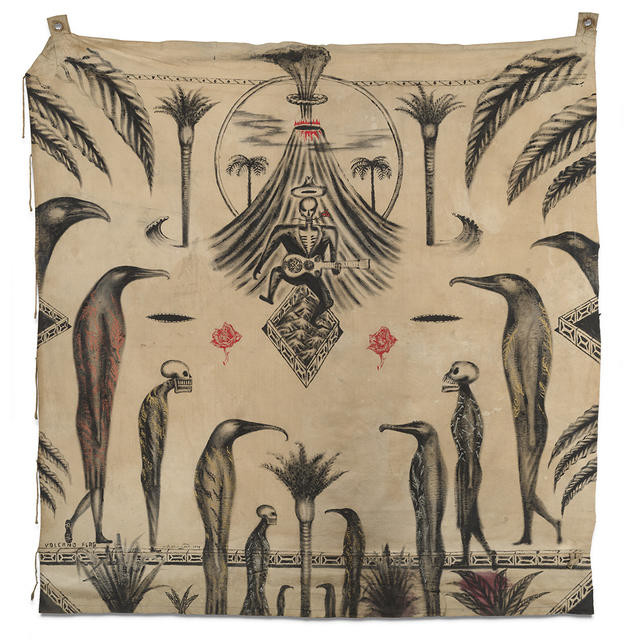Bill Hammond
Aotearoa New Zealand, b.1947, d.2021
Volcano Flag
- 1994
- Acrylic on canvas tent
- Purchased 2016
- 2005 x 1877mm
- 2016/003
Tags: birds (animals), brick (clay product), flowers (plants), guitars, musicians, patterns (design elements), skeleton and skeleton components, smoke (material), trees, volcanoes
Many locals fondly remember this painting hanging on the wall of the Lava Bar in the port town of Lyttelton throughout the 1990s and 2000s. The Lava Bar was one of Bill’s favourite haunts – he very occasionally played there in a band with no name. He swapped this painting to cover costs for a bar tab, and it quickly became part of the fabric of the place. Sadly, the Lava Bar was damaged in the earthquakes of 2010/11 and demolished shortly afterwards. Defiantly lowbrow in the Christchurch gothic tradition, Volcano Flag incorporates tattoo designs, a dancing skeleton playing a guitar, a mountain blowing smoke rings and a bird with a human skull for a head. It’s a painting that references the history of the local landscape: Whakaraupō (Lyttelton harbour), where the artist has lived and worked since the early 1970s, is the caldera of an ancient extinct volcano. Bill Hammond: Playing the Drums (3 August 2019 – 19 January 2020)
Exhibition History
Bill Hammond painted Volcano Flag in exchange for a food and beverages tab at Lyttelton’s Volcano Café (later the Lava Bar). It hung there for about fifteen years until the building was demolished following the Christchurch earthquakes of 2010–11. The front window of the café looked out across Lyttelton Harbour, the caldera of a vast extinct volcano which Hammond has imagined shooting ash plumes and blowing smoke rings.
Hammond’s birds, too, gesture towards a time before human habitation of New Zealand—an environment he had encountered a few years earlier on a trip to the Auckland Islands. “It’s bird land. You feel like a time-traveller, as if you have just stumbled upon it—primeval forests, rātās like Walt Disney would make. It’s a beautiful place, but it’s also full of ghosts, shipwrecks, death.” Different stories and timeframes and images collide in Hammond’s canvasses as if in a dream, or as if fragments of consciousness were projected on a screen. “I don’t have a tight brief,” he says. “I fumble around history, picking up bits and pieces.”
In the 1980s and 90s, he used discarded objects from everyday life—strips of wallpaper, coffee tables and the reverse side of commercial signs—as grounds for his work. He painted Volcano Flag on a canvas World War I army tent that he found in the basement of his house, leaving it on the washing line for several years to bleach in the sun and rain. “I like things that have acquired a patina of time”, he said. Its sister work, Buller’s Table Cloth, painted on the other side of the tent, is in the collection of Auckland Art Gallery.
With its square format and dancing skeleton guitarist, Volcano Flag looks a bit like an album cover for an unnamed southern gothic band—and points to the distinctive relationship between art, contemporary music and the landscape in the Canterbury region.
(Your Hotel Brain 13 May 2017 - 8 July 2018)



